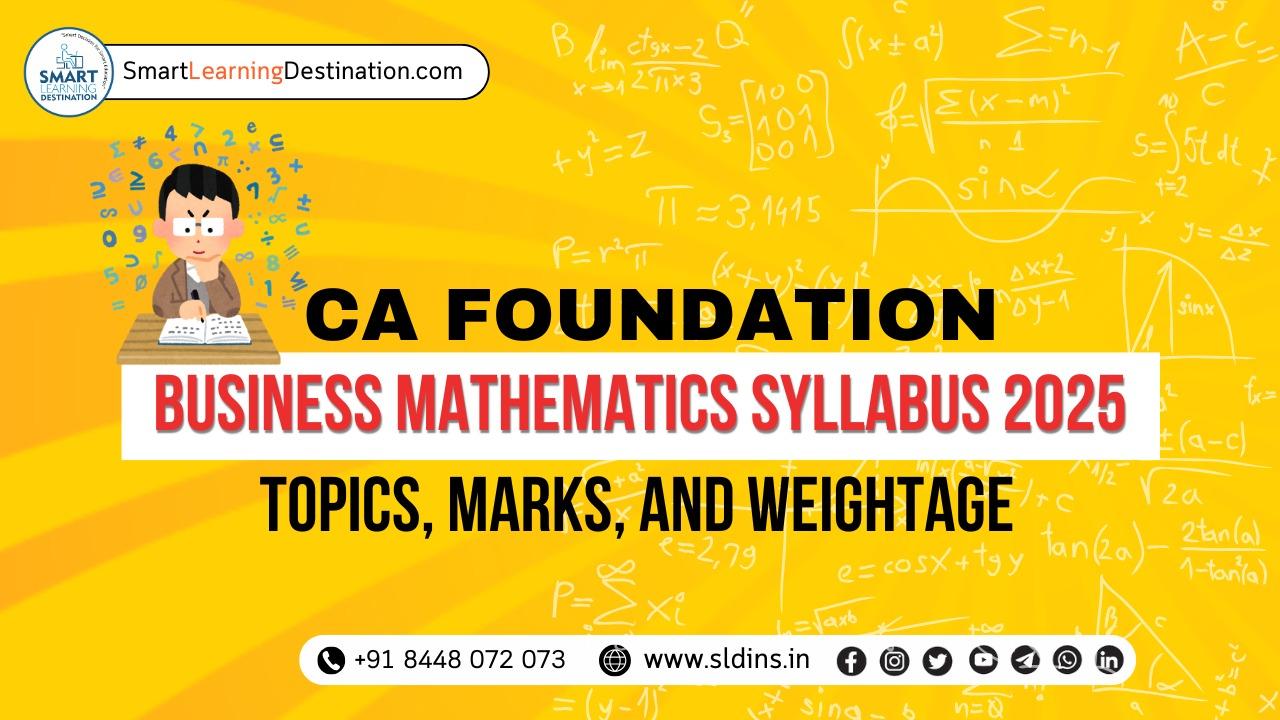CA Foundation Business Mathematics Syllabus 2025: Topics, Marks, and Weightage
The CA Foundation course includes Paper 3, which is Quantitative Aptitude, consisting of Business Mathematics, Logical Reasoning, and Statistics. This paper is considered one of the more challenging components of the CA Foundation exam. Scoring well requires regular practice and a clear understanding of the concepts. Here, we provide a detailed breakdown of the CA Foundation Business Mathematics syllabus, marking scheme, chapter weightage, and study strategies to help you excel in the 2025 exams.
Short Summary
The CA Foundation Paper 3, Quantitative Aptitude, is divided into three sections:
- Business Mathematics: 40 marks
- Logical Reasoning: 20 marks
- Statistics: 40 marks
The syllabus covers foundational and advanced mathematical concepts, reasoning skills, and statistical methods. By understanding the weightage and chapter importance, students can effectively plan their study schedule and ace the exam.
Key Highlights
- Total Marks: 100
- Duration: 2 hours
- Paper Pattern: Objective
- Focus Areas: Logical reasoning, analytical skills, mathematical calculations, and data interpretation.
Detailed Syllabus
Part A: Business Mathematics (40 Marks)
This section focuses on mathematical concepts that are fundamental to business applications:
- Ratio and Proportion, Indices, and Logarithms
- Basic principles and their applications in business.
- Equations
- Linear and quadratic equations relevant to business operations.
- Linear Inequalities
- Inequalities in one variable, solution space, and optimal solutions.
- Mathematics of Finance
- Time value of money, simple and compound interest, annuities.
- Permutations and Combinations
- Basic concepts and their role in probability and business scenarios.
- Sequence and Series
- Arithmetic and geometric progressions.
- Sets, Relations, and Functions
- Basics of limits and continuity in business and economics.
- Differential and Integral Calculus
- Applications in business and economic analysis.
Part B: Logical Reasoning (20 Marks)
This section assesses problem-solving skills and logical aptitude:
- Number Series, Coding-Decoding, and Odd Man Out
- Patterns and sequences to develop logical thinking.
- Direction Tests
- Evaluating spatial reasoning abilities.
- Seating Arrangements
- Logical arrangement of entities.
- Blood Relations
- Analyzing relationships through logical connections.
Part C: Statistics (40 Marks)
Statistics emphasizes data interpretation and probability concepts:
- Statistical Representation of Data
- Diagrammatic representation, frequency distribution, histograms, and pie charts.
- Measures of Central Tendency and Dispersion
- Mean, median, mode, standard deviation, and variance.
- Probability
- Independent and dependent events, Bayes' theorem, and mathematical expectation.
- Theoretical Distributions
- Binomial, Poisson, and normal distributions.
- Correlation and Regression
- Understanding relationships between variables.
- Index Numbers
- Basics and business applications.
Chapter-Wise Weightage
|
Business Mathematics Topics |
Weightage |
|
Ratio and Proportion, Indices, Logarithms |
20%-30% |
|
Time Value of Money |
30%-40% |
|
Permutations, Combinations, Sets, Relations |
30%-50% |
|
Logical Reasoning Topics |
Weightage |
|
Number Series, Coding-Decoding, Odd Man Out |
60%-70% |
|
Blood Relations |
10%-15% |
|
Statistics Topics |
Weightage |
|
Measures of Central Tendency and Dispersion |
45%-50% |
|
Probability and Theoretical Distributions |
25%-30% |
Study Tips for CA Foundation Mathematics
- Master the Basics: Develop a clear understanding of fundamental concepts in all three sections.
- Regular Practice: Solve question papers, mock tests, and ICAI-provided sample papers.
- Organize Your Study: Maintain separate notes for Business Mathematics, Logical Reasoning, and Statistics.
- Use Calculator Shortcuts: Familiarize yourself with calculator functions to save time during the exam.
- Focus on High-Weightage Chapters: Prioritize topics based on their relevance and weightage.
Exam Pattern
- Total Questions: 100
- Exam Duration: 2 hours
- Marks Distribution:
- Business Mathematics: 40 marks
- Logical Reasoning: 20 marks
- Statistics: 40 marks
FAQs
- Is the CA Foundation Mathematics exam difficult to clear?
Yes, CA Foundation Mathematics is challenging due to its broad syllabus. Regular practice and understanding of concepts are crucial for success. - How can I clear the CA Foundation Maths exam?
Focus on high-weightage topics, practice consistently, and use ICAI-provided study materials. - Can a non-maths student clear Paper 3?
Yes, with consistent effort, understanding of concepts, and practice, non-maths students can clear the exam.
Conclusion
The CA Foundation Business Mathematics syllabus 2025 is comprehensive, covering a range of essential topics in mathematics, logical reasoning, and statistics. By focusing on the syllabus, weightage, and practicing consistently, students can excel in the exam and build a strong foundation for their CA journey.
For expert guidance, join Smart Learning Destination Classes for tailored CA Foundation coaching. Their comprehensive materials and expert mentors will help you achieve your goals. Enroll now to start your preparation journey today!
